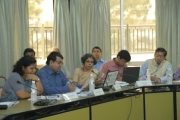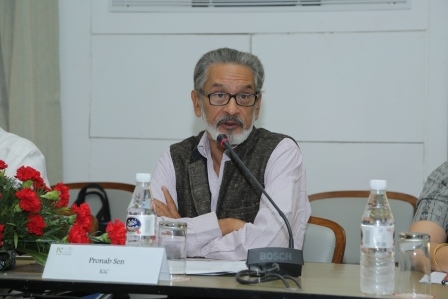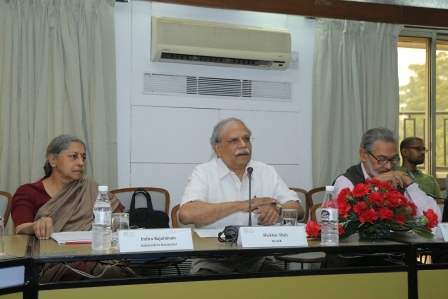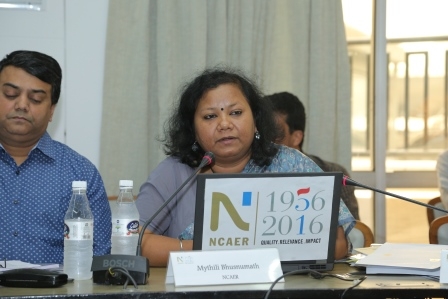NCAER presented the 2016-17 Mid Year Review (MYR) of Indian Economy at this seminar held in New Delhi. The MYR presents the most comprehensive, independent assessment of the Indian economy as the Indian Government and its Ministry of Finance begin preparation of the FY 2017-18 Union Budget.
Dr Shekhar Shah opened the seminar delivering his opening remarks, followed by Dr Pronab Sen, Country Director, International Growth Centre’s India Central Programme who was invited to chair the Review. Ms Mythili Bhusnurmath, Senior Consultant, NCAER and Dr Bornali Bhandari, Fellow, NCAER presented the main findings of the Review. The MYR provides an independent stocktaking of the Indian economy’s performance. The Review included two special presentations on ‘New Paradigms for Financial Sector Development in India’ and ‘Healthy Ageing in India: Situation and Challenges’. The first presentation by Dr Soumya Kanti Ghosh, Group Chief Economic Adviser, SBI assesses the four pillars of the financial sector in India. The second paper by Dr Debasis Barik, Associate Fellow, NCAER examines whether the Indian health delivery system is prepared to tackle the rise in communicable and non-communicable diseases among the elderly as India’s demography changes. During the latter half of the seminar, two invited discussants, Dr Indira Rajaraman, Member, 13th Finance Commission and Dr Shubhashis Gangopadhyay, Research Director, IDF, shared their comments.
Key highlights of the NCAER’s 2016-17 Mid-Year Review of the Indian Economy are as follows:
GDP Growth: NCAER places overall 2016-17 GDP growth (GDP at market prices), in constant 2011–12 prices, at 7.6%. On one hand, the anticipated improvement in the agricultural sector and the associated increase in rural demand will give an upward push to economic growth. The manufacturing sector is also giving positive signals with the Purchasers’ Managers Index and Index of Industrial Production for core sectors and auto sales going up. The domestic aviation sector growth continues to be robust. However, other service index indicators continue to be muted. Food inflation is also showing signs of dampening in the latter part of the second quarter. However, fuel inflation may revive. Although urban demand is predicted to remain strong, external demand continues to be volatile.
Agriculture: Unlike the past two years, this year witnessed a normalisation in rainfall at just short of the 100% long period average. The actual rainfall measured as an index on the basis of un-irrigated area under foodgrains as weights was 1.5 per cent above its normal level. Consequently, the area under kharif sowing is about 3.5% more than last year, with the sowing of pulses being about 29.1% more than last year. Thus, our estimates show that the output of kharif foodgrains is expected to reflect an increase of 10 per cent to 11 per cent over last year’s output of 124 million tonnes.
Industry: The Index of Industrial Production (IIP), a measure of industrial performance, shows a negative growth of (–) 0.27% during April-August, 2016–17, as compared with 0.45% growth recorded during the same period of 2015–16. The Gross Fixed Capital Formation (GFCF), a key indicator of investment in the economy, has shown a steady and precipitous fall since the second quarter of 2015–16. In the first quarter of the current fiscal 2016–17, the GFCF touched (–) 3.1%. The core sector showed a year-on-year (y-o-y) growth of 4.6% in 2016–17:H1 versus 2.6 per cent in 2015–16:H1. Six out of eight industries showed higher growth in the 2016–17:H1 as compared to the corresponding period in the last fiscal. The two major components of IIP by economic activities, i.e., Mining and Quarrying (0.6% in 2016 versus 1.4% in 2015) and Manufacturing (-1.2% in 2016 versus 4.5% in 2015) show lower rates of y-o-y growth in April–August 2016–17 as compared to 2015–16. The third major component, Electricity, shows higher growth in 2016–17 (5.1% in 2016-17:H1 versus 4.5% in 2015-16:H1).
Services: The growth of the services sector growth remained more or less stable in Q1 of FY17. But in a break from the past, public administration, defence and other services led the growth in the services sector with a growth of 12.3%, up from 5.9% in the comparable period during the last fiscal. Contrary to this, growth in activity in the services sector declined in September 2016. The Nikkei India Services Business Activity Index fell to 52 in September 2016, down from 54.7 in August (a reading above 50 shows expansion while a number below 50 shows contraction). Furthermore, construction sector activity, GVA growth in trade, hotels and transport slowed down. However, tourist arrivals increased sharply in July and August 2016, to 17.1% and 11.8%, respectively.
Inflation: After a sequential uptick in inflation in the initial months of FY17 to 6.07% in July 2016, it fell sharply in September 2016 to 4.31%, as measured by the Consumer Price Index (CPI). After declining for 17 consecutive months, the Wholesale Price Index (WPI) inflation turned positive in April 2016, remaining at around 3.5-3.7%. Food inflation was the swing element in both cases, accounting for both the uptick as well as decline.
Monetary Policy: The H1 of FY17 saw a revamping in monetary policy formulation with the appointment of the new RBI governor, Urjit Patel, and the operationalisation of the Monetary Policy Committee (MPC). After the cautious approach adopted by the previous Governor, the MPC unanimously decided to reduce the repo rate by 25 basis points. Furthermore, the Governor, in his post-policy briefing, hinted that the inflation target of 4% would be achieved over five years. The PSU banks continued to be plagued by NPAs and the credit and deposit growth remained sluggish.
External Sector: The first half of the year looked bright on the external front with the current account deficit (CAD) being within manageable limits. India’s merchandise exports turned positive in June 2016, with exports rising at 1.27% y-o-y in June to $22.57 billion, reversing the trend that started in December 2014 due to weak global demand and a fall in commodity prices. Furthermore, after a decline in July and August, exports grew at 4.6% in September, raising hopes that the decline period in Indian imports is coming to an end.
Fiscal Policy: India’s fiscal position remained under stress during H1of FY17. Despite healthy growth in tax revenues, the combination of rising expenditure and lower-than-expected non-tax revenues is likely to test the Government’s resolve to abide by the fiscal deficit target set out in Budget 2016-17. According to the latest numbers released by the Controller General of Accounts, the FD during the period April-September 2016 stood at 84% of the budget estimate for the year. This marks a considerable worsening over the comparable period last year when the FD stood at 68% of the Budget estimate. At 569.3% of the budget estimate, the primary deficit is more than double the deficit during the comparable period last year (182%), indicating that the Government truly has an uphill task on its hands to be able to stick to the targets laid down in Budget 2016-17. Tax collections (net to the Centre) are better at 42.5% of the BE with an improvement in both direct and indirect tax collections.
The Mid-Year Review of the Indian Economy was started at the India International Centre (IIC) in 1976 by Dr Malcolm S. Adiseshiah. Dr Adiseshiah was one of India’s most distinguished economists and educationists, Life Trustee of IIC, recipient of the Padma Bhushan, founder of the Madras Institute of Development Studies, and one of the key architects of UNESCO’s work on education and technical assistance. Now conducted in collaboration with the Malcolm and Elizabeth Adiseshiah Trust, Chennai, the Review has been presented by many distinguished Indian economists since Dr Adiseshiah’s passing away, MYR remains a tribute, in a long standing partnership with the India International Centre to one of India’s most prominent post-Independence economists, Dr Malcom S. Adiseshiah.










